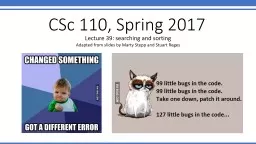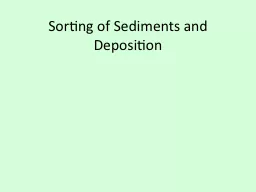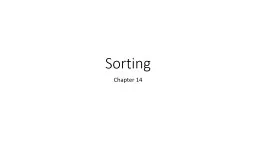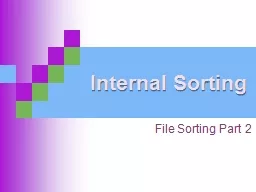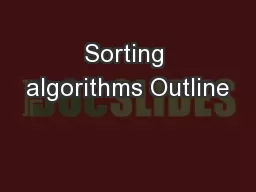PPT-Lecture 39: searching and sorting
Author : ginocrossed | Published Date : 2020-08-07
Adapted from slides by Marty Stepp and Stuart Reges CSc 110 Spring 2017 Using binarysearch index 0 1 2 3 4 5 6 7 8 9 10 11 12 13 14 15 a 4 2 7 9 15 19
Presentation Embed Code
Download Presentation
Download Presentation The PPT/PDF document "Lecture 39: searching and sorting" is the property of its rightful owner. Permission is granted to download and print the materials on this website for personal, non-commercial use only, and to display it on your personal computer provided you do not modify the materials and that you retain all copyright notices contained in the materials. By downloading content from our website, you accept the terms of this agreement.
Lecture 39: searching and sorting: Transcript
Adapted from slides by Marty Stepp and Stuart Reges CSc 110 Spring 2017 Using binarysearch index 0 1 2 3 4 5 6 7 8 9 10 11 12 13 14 15 a 4 2 7 9 15 19 25 28 30 36 42 50 56 68 85 . Insertion Sort. Insertion Sort. Sorting problem:. Given an array of N integers, rearrange them so that they are in increasing order.. Insertion sort. Brute-force sorting solution.. In each iteration . Agents of Deposition. The agents of erosion are also agents of deposition.. Depositional rate depends on sediment size, shape and density.. Depositional rate also depends on characteristics of the depositional agent.. Systematic review workshop. K U Leuven 4-6 June 2012. Janet Harris - Updated material from Angela . Harden, Three-day systematic review workshop, K U Leuven, 6. th. to 8. th. May 2011. Why develop a protocol?. Insertion Sort: . Θ. (n. 2. ). Merge Sort:. Θ. (. nlog. (n)). Heap Sort:. Θ. (. nlog. (n)). We seem to be stuck at . Θ. (. nlog. (n)). Hypothesis: . Every sorting algorithm requires . Ω. (. nlog. Sort these 6 socks. How to determine which comes first?. Compare 2 at a time. Draw arrows . from. . an “earlier” sock . to. . a “later” one.. As many arrows as you wish to show the sorting order you have decided.. Chapter 14. Selection. . Sort. A . sorting algorithm rearranges the elements of a collection so that they are stored . in . sorted order. . Selection sort sorts an array by repeatedly. . finding. Bubble Sort . of an array. Inefficient --- . O ( N. 2. ). easy to code. , . hence unlikely to contain errors. Algorithm. for . outerloop. = 1 to N. for . innerloop. = 0 to N-2. if ( item[. Information. Database. A database is a collection of data arranged for ease and speed of search and retrieval (The American Heritage Dictionary of English Language, 2000). . The . quality of being "... arranged for ease and speed of search and retrieval" is what distinguishes a database from a computer network.. Lauren Hoen & Parris Vitela. Introductions. Lauren Hoen. Training Specialist. Parris Vitela. Strategic Account Executive. Goals. Learning to find the right talent. Understanding . how Boolean Searching relates to:. banking. Stefano Callari, Alexander Moore, Laura . Rovegno . Competition and Markets Authority. †. . Pasquale . Schiraldi. . London School of Economics. 1. †. . Although the authors worked on certain aspects of the retail banking market investigation at the UK Competition and Markets Authority (CMA), the views and opinions expressed in this paper are the sole responsibility of the authors and do not necessarily reflect those of the CMA or the inquiry group. . In this lesson, we will:. Describe sorting algorithms. Given an overview of existing algorithms. Describe the sorting algorithms we will learn. Sorting. Given an array that has arbitrary entries, . int array[10]{82, 25, 32, 85, 16, 36, 40, 4, 28, . Systematic review workshop. K U Leuven 4-6 June 2012. Janet Harris - Updated material from Angela . Harden, Three-day systematic review workshop, K U Leuven, 6. th. to 8. th. May 2011. Why develop a protocol?. Hansang Bae. October 18th, 2016. CTO, Riverbed. Misc. http://. www.youtube.com/hansangb. http. ://. bit.ly/HSBBook. . https://. app.box.com/v/Sharkfest2016. (trace files and my Wireshark profiles are in the Sharkfest2016 link above). What is a databaseA databaseis defined as a place where information is collected stored and organized This information can also be viewed managed and updated oExamples of DatabasesaProQuestaEBSCOAcce
Download Document
Here is the link to download the presentation.
"Lecture 39: searching and sorting"The content belongs to its owner. You may download and print it for personal use, without modification, and keep all copyright notices. By downloading, you agree to these terms.
Related Documents

